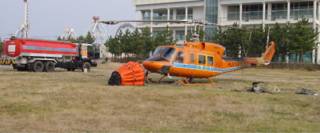Only recently have I considered, or actively worked to consider, that Korean driving style is merely an example of some flexibility of thought that Koreans may possess.
Below are three pictures of a three-way intersection. People unfamiliar with Korea will notice the lack of stop signs AND the presence of three stop-lines. There are very few stop signs in Korea and drivers need to exercise some judgment.


facing south
 facing north
facing north 

facing east

Below is a terrible picture. I should have hand drawn it and photographed it but I wanted to try the Windows picture editing software. What a nightmare. Whatever it looks like, the picture is meant to show the above three-way intersection in Yangyang with two cars turning, as I observed them a few months ago. The car pointing East and turning North pulled into traffic; the the car heading North and turning West went 'over' or inside him, driving on the wrong side of the road until past the first car before pulling onto the proper side of the road (driving is on the right side, as in North America).
 flexible thinking or terrible driving...or terrible artwork?
flexible thinking or terrible driving...or terrible artwork? 
I thought this was pretty scary driving. I decided, as an exercise in tolerance, to consider it in a more positive way. Okay, because the first car had pulled out and was partially blocking traffic, both drivers may have halted to see what solution the other driver might attempt. By turning inside of the first car, the second driver minimized delay for both drivers. I don't think I could drive on the wrong side of the road through an intersection like this one.
Wow. Mission accomplished. Maybe Korean drivers aren't bad drivers in general but are better at seeing options that I would have missed.
No. No! NO! While crossing a highway on my bike at a stoplight intersection while I had the green and having to stop for a bus going a little late through a red light (completely understandable), I was almost hit by the next bus trying to remain in convoy. The first bus had screened me so we were pretty close when he had to brake and I had to restart my heart. As a tiny cyclist going through a major intersection, I make sure that I am following the rules and doing everything correctly. I might have been hard to see, but if the bus driver had obeyed the law and stopped at the red light, I wouldn't have gasped for breath for the next few minutes as adrenaline charged through me.
Anyway, I am back to thinking that Koreans, in general, are terrible drivers. Should they be reading, my brothers-in-law are excellent drivers. Jong-wang might deserve his self-bestowed title of 'best driver'.
I have often considered carrying a doll, as lifelike as I could cheaply find, to throw into the air in front of cars running red lights as I try to use the crosswalk. I have matured a little, as back in my university days I might not have been able to predict a terrible traffic accident as the most likely outcome to the doll throwing scheme. Still, I'm tempted.





















